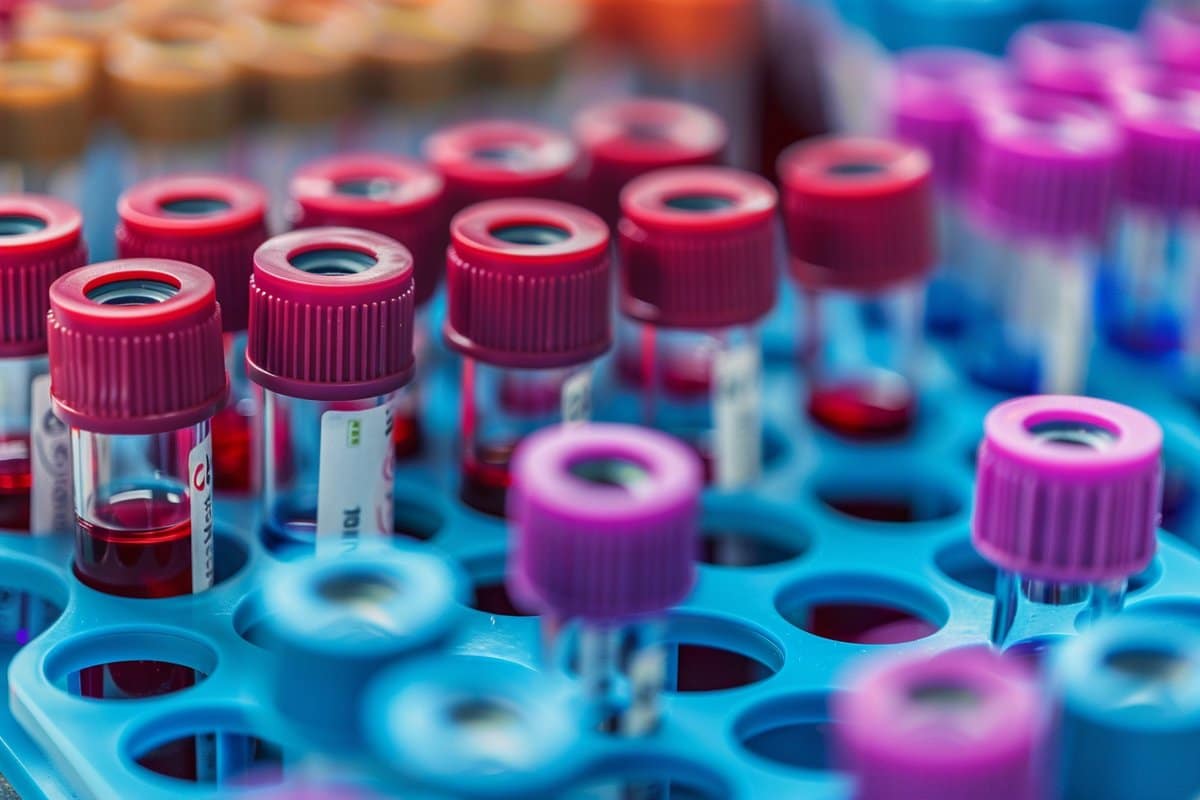Summary: Researchers identified a specific pattern of autoantibodies in the blood that precedes the clinical onset of multiple sclerosis (MS), potentially paving the way for early diagnosis and treatment. Their study found that 10% of MS patients displayed a unique set of autoantibodies against both human proteins and common pathogens like the Epstein-Barr Virus years before showing symptoms.
These findings could lead to a simple blood test for early detection of MS, allowing for timely intervention with more effective therapies. This discovery holds promise for transforming the management of MS, moving towards earlier and more precise treatments.
Key Facts:
- Researchers detected autoantibodies in 10% of MS patients that bind to a chemical pattern found in common viruses, indicating an immune response years before any clinical symptoms.
- The study used blood samples from the U.S. Department of Defense Serum Repository, analyzing samples from before and after the diagnosis of 250 MS patients.
- This pattern of autoantibodies was consistent across different cohorts and was found to be 100% predictive of an MS diagnosis, highlighting its potential as a biomarker.
Source: UCSF
In a discovery that could hasten treatment for patients with multiple sclerosis (MS), UC San Francisco scientists have discovered a harbinger in the blood of some people who later went on to develop the disease.
In about 1 in 10 cases of MS, the body begins producing a distinctive set of antibodies against its own proteins years before symptoms emerge.
These autoantibodies appear to bind to both human cells and common pathogens, possibly explaining the immune attacks on the brain and spinal cord that are the hallmark of MS.
The findings were published in Nature Medicine on April 19.
MS can lead to a devastating loss of motor control, although new treatments can slow the progress of the disease and, for example, preserve a patient’s ability to walk.
The scientists hope the autoantibodies they have discovered will one day be detected with a simple blood test, giving patients a head start on receiving treatment.
“Over the last few decades, there’s been a move in the field to treat MS earlier and more aggressively with newer, more potent therapies,” said UCSF neurologist Michael Wilson, MD, a senior author of the paper.
“A diagnostic result like this makes such early intervention more likely, giving patients hope for a better life.”
Linking infections with autoimmune disease
Autoimmune diseases like MS are believed to result, in part, from rare immune reactions to common infections.
In 2014, Wilson joined forces with Joe DeRisi, PhD, president of the Chan Zuckerberg Biohub SF and a senior author of the paper, to develop better tools for unmasking the culprits behind autoimmune disease.
They took a technique in which viruses are engineered to display bits of proteins like flags on their surface, called phage display immunoprecipitation sequencing (PhIP-Seq), and further optimized it to screen human blood for autoantibodies.
PhIP-Seq detects autoantibodies against more than 10,000 human proteins, enough to investigate nearly any autoimmune disease. In 2019, they successfully used it to discover a rare autoimmune disease that seemed to arise from testicular cancer.
MS affects more than 900,000 people in the US. Its early symptoms, like dizziness, spasms, and fatigue, can resemble other conditions, and diagnosis requires careful analysis of brain MRI scans.
The phage display system, the scientists reasoned, could reveal the autoantibodies behind the immune attacks of MS and create new opportunities to understand and treat the disease.
The project was spearheaded by first co-authors Colin Zamecnik, PhD, a postdoctoral researcher in DeRisi’s and Wilson’s labs; and Gavin Sowa, MD, MS, former UCSF medical student and now internal medicine resident at Northwestern University.
They partnered with Mitch Wallin, MD, MPH, from the University of Maryland and a senior author of the paper, to search for autoantibodies in the blood of people with MS. These samples were obtained from the U.S. Department of Defense Serum Repository, which stores blood taken from armed service members when they apply to join the military.
The group analyzed blood from 250 MS patients collected after their diagnosis, plus samples taken five or more years earlier when they joined the military. The researchers also looked at comparable blood samples from 250 healthy veterans.
Between the large number of subjects and the before-and-after timing of the samples, it was “a phenomenal cohort of individuals to look at to see how this kind of autoimmunity develops over the course of clinical onset of this disease,” said Zamecnik.
A consistent signature of MS
Using a mere one-thousandth of a milliliter of blood from each time point, the scientists thought they would see a jump in autoantibodies as the first symptoms of MS appeared.
Instead, they found that 10% of the MS patients had a striking abundance of autoantibodies years before their diagnosis.
The dozen or so autoantibodies all stuck to a chemical pattern that resembled one found in common viruses, including Epstein-Barr Virus (EBV), which infects more than 85% of all people, yet has been flagged in previous studies as a contributing cause for MS.
Years before diagnosis, this subset of MS patients had other signs of an immune war in the brain. Ahmed Abdelhak, MD, co-author of the paper and a postdoctoral researcher in the UCSF laboratory of Ari Green, MD, found that patients with these autoantibodies had elevated levels of neurofilament light (Nfl), a protein that gets released as neurons break down.
Perhaps, the researchers speculated, the immune system was mistaking friendly human proteins for some viral foe, leading to a lifetime of MS.
“When we analyze healthy people using our technology, everybody looks unique, with their own fingerprint of immunological experience, like a snowflake,” DeRisi said.
“It’s when the immunological signature of a person looks like someone else, and they stop looking like snowflakes that we begin to suspect something is wrong, and that’s what we found in these MS patients.”
A test to speed patients toward the right therapies
To confirm their findings, the team analyzed blood samples from patients in the UCSF ORIGINS study. These patients all had neurological symptoms and many, but not all, went on to be diagnosed with MS.
Once again, 10% of the patients in the ORIGINS study who were diagnosed with MS had the same autoantibody pattern. The pattern was 100% predictive of an MS diagnosis. Across both the Department of Defense group and the ORIGINS group, every patient with this autoantibody pattern had MS.
“Diagnosis is not always straightforward for MS, because we haven’t had disease specific biomarkers,” Wilson said. “We’re excited to have anything that can give more diagnostic certainty earlier on, to have a concrete discussion about whether to start treatment for each patient.”
Many questions remain about MS, ranging from what’s instigating the immune response in some MS patients to how the disease develops in the other 90% of patients. But the researchers believe they now have a definitive sign that MS is brewing.
“Imagine if we could diagnose MS before some patients reach the clinic,” said Stephen Hauser, MD, director of the UCSF Weill Institute for Neurosciences and a senior author of the paper. “It enhances our chances of moving from suppression to cure.”
For funding and disclosures, see the paper.
Other UCSF authors are Ravi Dandekar, Rebecca D. Bair, Kristen J. Wade, Christopher M. Bartley, Asritha Tubati, Refujia Gomez, Camille Fouassier, Chloe Gerungan, Jessica Alexander, Anne E. Wapniarski, Rita P. Loudermilk, Erica L. Eggers, Kelsey C. Zorn, Kirtana Ananth, Nora Jabassini, Sabrina A. Mann, Nicholas R. Ragan, Adam Santaniello, Roland G. Henry, Sergio E. Baranzini, Scott S. Zamvil, Riley M. Bove, Chu-Yueh Guo, Jeffrey M. Gelfand, Richard Cuneo, H.-Christian von Büdingen, Jorge R. Oksenberg, Bruce AC Cree, Jill A. Hollenbach, and Ari J. Green. For all authors, see the paper.
About this multiple sclerosis research news
Author: Levi Gadye
Source: UCSF
Contact: Levi Gadye – UCSF
Image: The image is credited to Neuroscience News
Original Research: Closed access.
“An autoantibody signature predictive for multiple sclerosis” by Michael Wilson et al. Nature Medicine
Abstract
An autoantibody signature predictive for multiple sclerosis
Although B cells are implicated in multiple sclerosis (MS) pathophysiology, a predictive or diagnostic autoantibody remains elusive.
In this study, the Department of Defense Serum Repository (DoDSR), a cohort of over 10 million individuals, was used to generate whole-proteome autoantibody profiles of hundreds of patients with MS (PwMS) years before and subsequently after MS onset.
This analysis defines a unique cluster in approximately 10% of PwMS who share an autoantibody signature against a common motif that has similarity with many human pathogens.
These patients exhibit antibody reactivity years before developing MS symptoms and have higher levels of serum neurofilament light (sNfL) compared to other PwMS.
Furthermore, this profile is preserved over time, providing molecular evidence for an immunologically active preclinical period years before clinical onset.
This autoantibody reactivity was validated in samples from a separate incident MS cohort in both cerebrospinal fluid and serum, where it is highly specific for patients eventually diagnosed with MS.
This signature is a starting point for further immunological characterization of this MS patient subset and may be clinically useful as an antigen-specific biomarker for high-risk patients with clinically or radiologically isolated neuroinflammatory syndromes.

Dr. Debi Johnson is a medical expert and health journalist dedicated to promoting well-being. With a background in medicine, she offers evidence-based insights into health trends and wellness practices. Beyond her reporting, Dr. Debi enjoys hiking, yoga, and empowering others to lead healthier lives.








